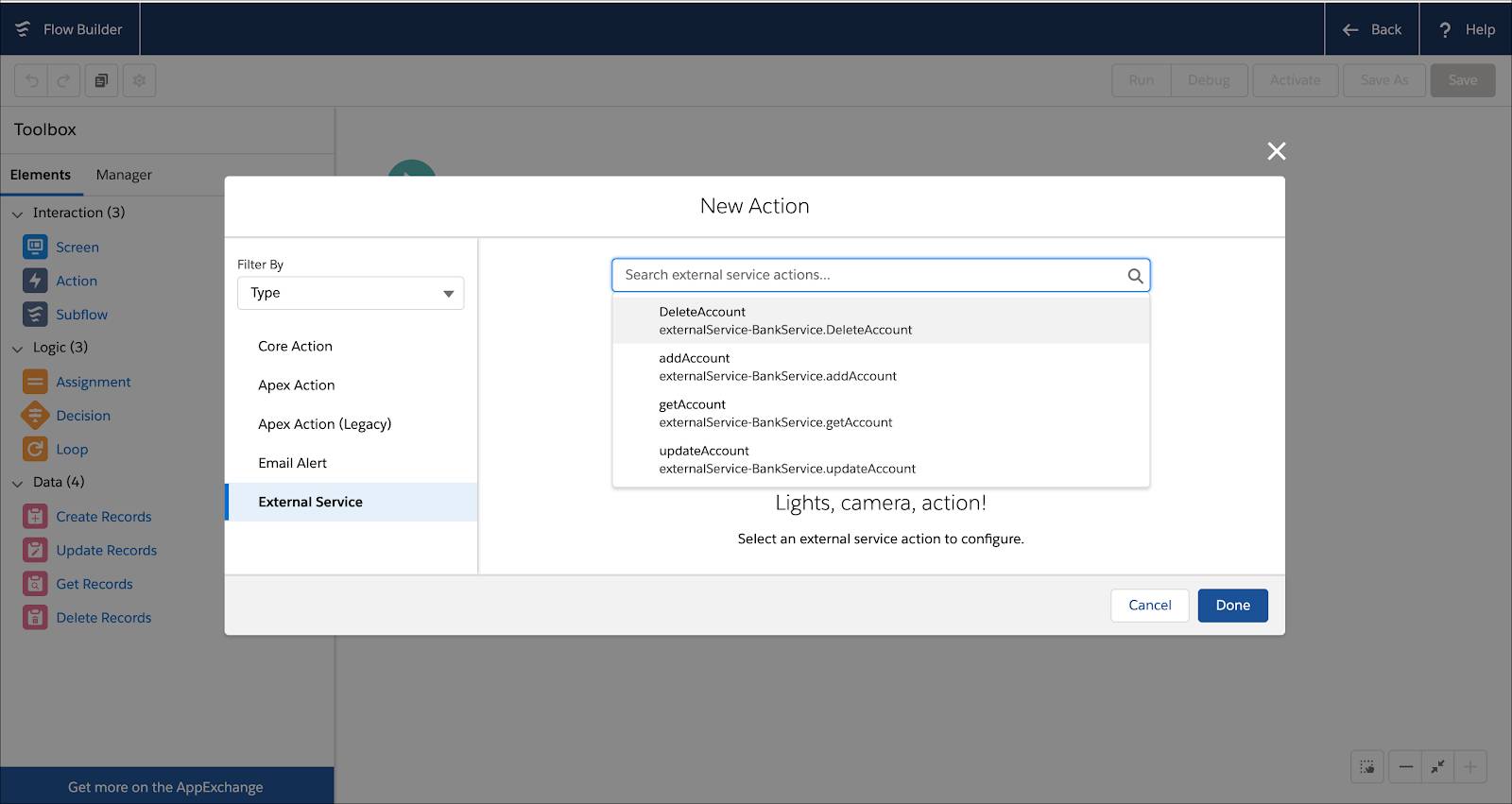Acceder a acciones de negocio externas
Creemos un flujo que ponga en práctica lo que aprendió y configuró hasta ahora. ¿Está listo para probar sus habilidades e implementar nuestro proceso de negocio? ¡Allá vamos!
Ver acciones de servicio externo en el flujo
En el paso anterior, registró un servicio externo mediante el asistente de servicios externos y visualizó sus acciones en él. Para ver las acciones, vayamos a Flow Builder.
- Haga clic en el Iniciador de aplicación (
 ).
).
- En las aplicaciones de búsqueda y el cuadro de búsqueda, ingrese
autoy, luego, seleccione Automation (Automatización).
- En el panel Flow (Flujos), haga clic en New (Nueva).
- En Frequently Used (Utilizado frecuentemente), seleccione Screen Flow (Flujo de pantalla).
- En la barra de botones, modifique la configuración Auto-Layout (Formato automático) a Free-Form (Forma libre).
- Desde la caja de herramientas, con la ficha Elements (Elementos) seleccionada, arrastre Action (Acción) al lienzo.
- Para ver las acciones importadas por servicios externos en función de la especificación de API que utilizamos en el paso anterior, modifique Filter By (Filtrar por) como Type (Tipo), seleccione External Service (Servicio externo) y haga clic en el cuadro de búsqueda.
- Para ver las acciones agrupadas por un registro de servicios externos (en este ejemplo, BankService), modifique Filter By (Filtrar por) como Category (Categoría), seleccione BankService y haga clic en el cuadro de búsqueda. Cuando termine de ver las acciones disponibles de BankService, podremos avanzar
- Haga clic en Cancel (Cancelar) para regresar a Setup (Configuración).

Puede ver la acción getAccount que buscamos en el asistente de servicios externos, junto con addAccount, DeleteAccount y updateAccount. Estas acciones de servicios externos son las operaciones de API referentes a nuestro banco ficticio que podemos utilizar en un flujo para obtener información, agregar registros de cuentas, entre otras opciones.
Los servicios externos que cree pueden tener muchas más acciones. Dependerá del servicio específico que utilice y cómo se define el esquema de la especificación de API para su caso de uso. Ahora vamos a utilizar estas acciones en un flujo propio.
Crear campos personalizados
Primero, creemos dos campos personalizados, Account Type (Tipo de cuenta) y Account ID (Id. de cuenta), en el objeto User (Usuario). Esto proporciona campos en el registro de usuario para almacenar el tipo y la Id. de la cuenta bancaria que recupera del servicio de banco.
- En Setup (Configuración), seleccione Object Manager (Gestor de objetos) y, luego, User (Usuario).
- Haga clic en Fields & Relationships (Campos y relaciones) y, a continuación, en New (Nuevo).
- En Data Type (Tipo de datos), seleccione Text (Texto) y haga clic en Next (Siguiente).
- En Field Label (Etiqueta de campo), ingrese
Account Type(Tipo de cuenta).
- Para Length (Longitud), ingrese
25.
- En Field Name (Nombre de campo), ingrese
Account_Type.
- No realice cambios en el resto de las opciones de configuración predeterminadas y haga clic en Next (Siguiente).
- Corrobore que la seguridad a nivel de campo esté configurada como visible para los perfiles que utiliza en su organización y haga clic en Next (Siguiente) y en Save & New (Guardar y nuevo).
- En Data Type (Tipo de datos), seleccione Text (Texto) y haga clic en Next (Siguiente).
- En Field Label (Etiqueta de campo), ingrese
Account ID(Id. de cuenta).
- Para Length (Longitud), ingrese
25.
- En Field Name (Nombre de campo), ingrese
Account_ID.
- No realice cambios en el resto de las opciones de configuración predeterminadas y haga clic en Next (Siguiente).
- Corrobore que la seguridad a nivel de campo esté configurada como visible para los perfiles que utiliza en su organización y haga clic en Next (Siguiente).
- Haga clic en Save (Guardar).
Crear un registro de usuario
A continuación, cree un registro de usuario para su cliente, Maria Thompson.
- En Setup (Configuración), ingrese
Users(Usuarios) en el cuadro de búsqueda rápida y, luego, seleccione Users (Usuarios).
- Haga clic en New User (Nuevo usuario).
- En First Name (Nombre), ingrese
Maria - En Last Name (Apellido), ingrese
Thompson - En User License (Licencia de usuario), seleccione Salesforce Platform.
- En Profile (Perfil), seleccione Standard Platform User (Usuario de plataforma estándar).
- Como esta es una organización de prueba, utilice su propia dirección de email.
- Ingrese un nombre de usuario que tenga el aspecto de una dirección de email. Los nombres de usuario deben ser únicos en TODO Salesforce. Elija un nombre de usuario como el siguiente:
-
externo.<suapellido>@<suempresa>.com
- … o bien, cree un nombre de usuario de su elección que sea único.
- Haga clic en Save (Guardar).
Si tiene curiosidad, ahora puede verificar que su usuario, Maria Thompson, tenga los dos campos personalizados nuevos en su cuenta de usuario de Salesforce, Account Type (Tipo de Cuenta) y Account ID (Id. de cuenta). Como podría esperarse, ambos campos se encuentran vacíos en este momento.
A Maria Thompson le gustaría abrir una cuenta de verificación en su banco. Creó un usuario para ella en Salesforce (un paso necesario, según nuestra lógica de negocio). Ahora, vamos a facilitar la tarea a los representantes del banco para que puedan completar el proceso de creación de cuenta nueva y utilizar todo el potencial de Salesforce para realizar un seguimiento de las nuevas cuentas bancarias.
Comencemos a trabajar en nuestro flujo.
